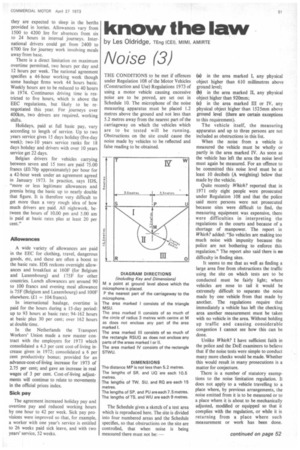know the law
Page 53

If you've noticed an error in this article please click here to report it so we can fix it.
by Les Oldridge, TEng (CEI), MIMI, AM1RTE
Noise (3)
THE CONDITIONS to be met if offences under Regulation 108 of the Motor Vehicles (Construction and Use) Regulations 1973 of using a motor vehicle causing excessive noise are to be proved, are set out in Schedule 10. The microphone of the noise measuring apparatus must be placed 1.2 metres above the ground and not less than 5.2 metres away from the nearest part of the carriageway on which the vehicles which are to be tested will be running. Obstructions on the site could cause the noise made by vehicles to be reflected and false reading to be obtained.
DIAGRAM DIRECTIONS (including Key and Dimensions)
M a point at ground level above which the microphone is placed.
P the nearest part of the carriageway to the microphone.
The area marked I consists of the triangle MSU.
The area marked II consists of so much of the circle of radius 3 metres with centre at M as does not enclose any part of the area marked I.
The area marked III consists of so much of the rectangle RSUQ as does not enclose any parts of the areas marked I or II.
The area marked IV consists of the rectangle STWU.
DIMENSIONS The distance MP is not less than 5.2 metres. The lengths of SR, and UQ are each 10.5 metres.
The lengths of TW, SU. and RQ are each 15 metres.
The lengths of SP. and PU are each 7.5 metres. The lengths of TS, and WU are each 9 metres.
The Schedule gives a sketch of a test area which is reproduced here. The site is divided into four numbered areas and the Schedule specifies, so that obstructions on the site are controlled, that when noise is being measured there must not be: — (a) in the area marked I, any physical object higher than 610 millimetres above ground level; (b) in the area marked II, any physical object higher than 920mm; (c) in the area marked III or IV, any physical object higher than 1525mm above ground level (there are certain exceptions to this requirement).
The vehicle itself, the measuring apparatus and up to three persons are not included as obstructions in this list.
When the noise from a vehicle is measured the vehicle must be wholly or partly in the area marked IV. As soon as the vehicle has left the area the noise level must again be measured. For an offence to be committed this noise level must be at least 10 decibels (A weighting) below that made by the vehicle.
Quite recently Which? reported that in 1971 only eight people were prosecuted under Regulation 108 and that the police said more persons were not prosecuted because sites were difficult to find, the measuring equipment was expensive, there were difficulties in interpreting the regulations in the courts and because of a shortage of manpower. The report in Which? added: "So vehicles are making too much noise with impunity because the police are not bothering to enforce this regulation." The report also said there is no difficulty in finding sites.
It seems to me that as well as finding a large area free from obstructions the traffic using the site on which tests are to be conducted must be fairly light; where vehicles are nose to tail it would be extremely difficult to separate the noise made by one vehicle from that made by another. The regulations require that immediately a vehicle has left the checking area another measurement must be taken with no vehicle in the area. Without holding
up traffic and causing considerable congestion I cannot see how this can be done.
Unlike Which? I have sufficient faith in the police and the DoE examiners to believe that if the noise tests were simple to conduct many more checks would be made. Whether this would result in many prosecutions is a matter for conjecture.
There is a number of statutory exemptions to the noise limitation regulation. It does not apply to a vehicle travelling to a place where, by previous arrangements, the noise emitted from it is to be measured or to a place where it is about to be mechanically adjusted, modified or equipped so that it complies with the regulation, or while it is returning from a place where such measurement or work has been done.












































































































